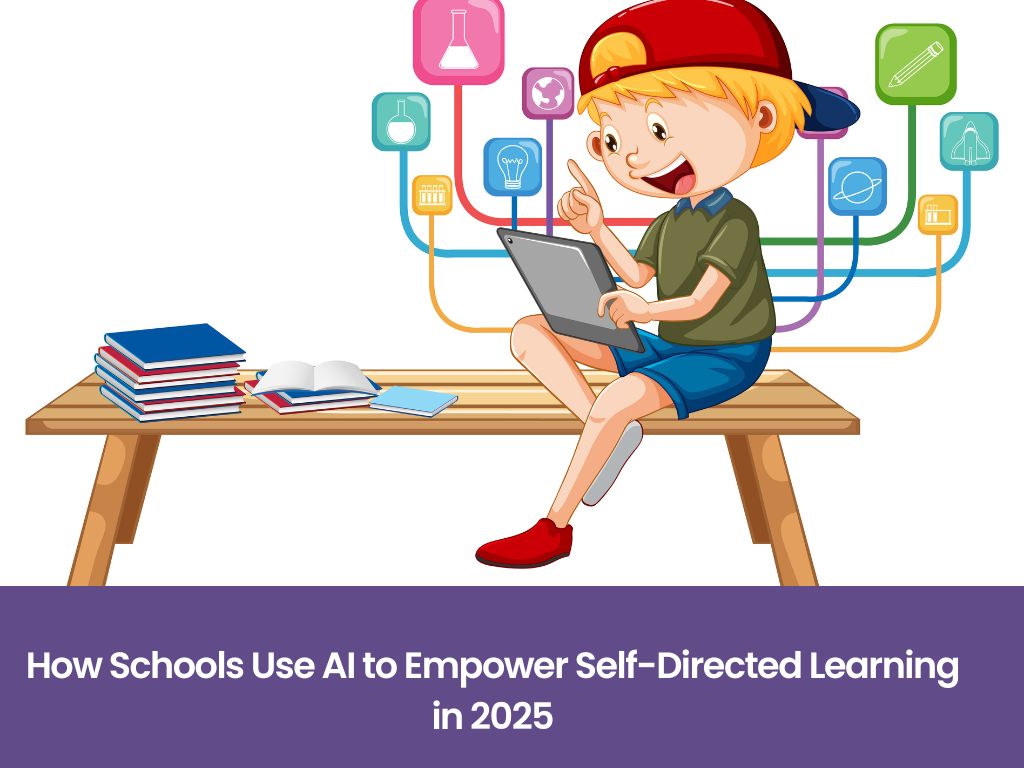How Schools Use AI to Empower Self-Directed Learning in 2025
posted on Nov 19, 2025
Discover how AI tools help schools build independent, motivated learners. Learn how self-directed learning is transforming classrooms in 2025.

Introduction
Education in 2025 is evolving faster than ever, and one of the biggest shifts we are witnessing is the rise of self-directed learning—a learning approach where students take ownership of their academic journey. Today’s learners no longer rely only on teacher-led instruction; instead, they explore, question, and discover concepts independently. What’s fueling this transformation? Artificial Intelligence (AI).
AI has become a powerful catalyst in reshaping classroom experiences by providing personalized pathways, adaptive tools, and 24/7 learning support. Schools across India and the world are integrating AI into their academic models to empower students with the skills they need to thrive in the future. Even institutions like Bgs Vijnatham School , one of the Best Schools in Greater Noida west are embracing AI-forward approaches to enrich self-directed learning and build confident, independent thinkers.
In this blog, let’s explore how schools can use AI to strengthen self-directed learning and why this combination is shaping the future of education.
What Is Self-Directed Learning and Why Does It Matter Today?
Self-directed learning is an approach where students:
-
Set their own learning goals
-
Choose how to approach a topic
-
Manage their own time and progress
-
Reflect on their learning outcomes
This method is essential in 2025 because students must be prepared for a world where continuous learning, adaptability, and problem-solving define success. Employers value individuals who can learn independently, manage tasks, and adapt to new knowledge and skills without constant supervision. When schools encourage self-directed learning, they help students grow into lifelong learners—a quality that will always remain valuable.
AI plays a crucial role in making this possible by offering tools and platforms that guide students without replacing the teacher.
One of the strongest advantages of using AI in classrooms is personalization. Every child learns differently, and AI helps in understanding these differences through:
-
real-time performance tracking
-
difficulty-level adjustments
-
customized content recommendations
-
skill-level insights
AI-powered platforms analyze how students interact with lessons, where they struggle, and what engages them most. Based on this data, the system creates individualized learning paths that challenge each child at the right pace. This makes self-directed learning more effective, as students receive guidance tailored to their needs.
2. AI-Powered Tools for Independent Learning
Various AI tools enable students to learn independently without waiting for teacher instructions. Some of the most impactful tools include:
a. AI Tutors and Chatbots
AI tutors simulate 1–on-1 guidance, answer questions, re-explain topics, and provide examples instantly. They are available round the clock, making self-learning more flexible and accessible.
These platforms adjust the lesson difficulty depending on the student’s performance. Struggling students get simplified explanations, while advanced learners receive enrichment activities.
c. Content Recommendation Engines
Similar to how streaming apps suggest shows, AI recommends videos, articles, quizzes, and puzzles based on the child’s interests and performance patterns.
d. Voice-Enabled Learning Assistants
Voice tools help young learners stay engaged and support children with reading or writing challenges.
These tools help students gain confidence as they explore topics independently, without feeling overwhelmed.
3. AI Encourages Curiosity and Exploration
Curiosity is the foundation of self-directed learning. AI tools encourage curiosity by exposing students to new ideas, interactive simulations, virtual labs, and videos that spark interest.
For example:
-
A child learning about space can explore a 3D solar system model.
-
A student curious about coding can try AI-generated coding challenges.
-
Learners studying history can take virtual reality tours of ancient civilizations.
Such immersive experiences allow students to learn beyond textbooks, making learning an active and engaging process.
4. AI Enhances Time Management and Goal-Setting Skills
Self-directed learning requires strong time management, planning, and goal-setting. AI-supported systems help students develop these skills through:
-
digital planners
-
automated reminders
-
goal-tracking dashboards
-
progress analytics
When children can see their learning progress visually, they become more motivated to keep going. This accountability supports discipline and encourages independent study habits.
5. AI Supports Teachers, Not Replaces Them
A common misconception is that AI replaces teachers. In reality, AI acts as a teaching assistant, while educators remain the heart of the classroom.
Teachers use AI insights to:
-
identify learning gaps
-
understand student strengths
-
create differentiated tasks
-
provide targeted feedback
-
support individual learning goals
This helps the teacher spend more time on meaningful interaction, project-based learning, and emotional support—key elements of self-directed learning.
Schools that marry human expertise with AI insights create the perfect environment for students to take control of their learning journey.
6. Building Future-Ready Learners Through AI
When students practice self-directed learning with AI support, they develop essential skills such as:
-
critical thinking
-
problem solving
-
creativity
-
digital literacy
-
adaptability
-
intrinsic motivation
These are the core abilities needed to succeed in higher education and future careers. Forward-thinking schools like Bgs Vijnatham School , one of the Best School in Noida Extension are integrating AI tools to help students strengthen these abilities early in their academic journey.
Conclusion
AI is not just a technological trend—it is a powerful educational partner. When used thoughtfully in schools, AI enhances self-directed learning by offering personalized support, adaptive tools, and engaging learning experiences. It equips students with confidence, independence, and future-ready skills. As education continues to evolve in 2025 and beyond, the combination of AI + self-directed learning is set to redefine classrooms and empower students like never before.